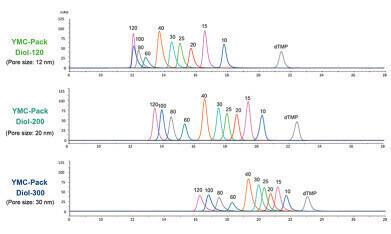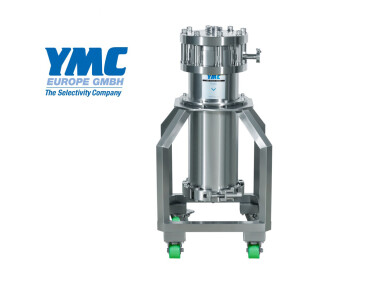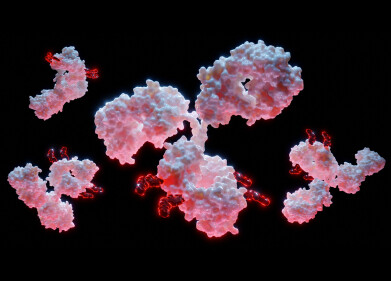-
 Figure 3: Comparison of the elution volume of ssDNA and dsDNA by using YMC-Pack Diol columns with different pore sizes. Selected corresponding ssDNA and dsDNA pairs of the same number of bases are marked.
Figure 3: Comparison of the elution volume of ssDNA and dsDNA by using YMC-Pack Diol columns with different pore sizes. Selected corresponding ssDNA and dsDNA pairs of the same number of bases are marked. -
 Figure 1: Pore size selection for separation of oligonucleotides by YMC-Pack Diol columns
Figure 1: Pore size selection for separation of oligonucleotides by YMC-Pack Diol columns
Columns (LC)
Pore size selection for separation of oligonucleotides by YMC-Pack Diol columns
Jul 25 2023
Oligonucleotides cover a broad field of applications ranging from molecular biology to therapy and diagnosis. Some oligonucleotides, such as antisense oligonucleotides, act as single-strands, but also double stranded oligonucleotides exist, such as the case of small interfering RNA (siRNA) duplexes. So far, the oligonucleotide length usually ranges from 12–25mer; however, the demand for longer oligonucleotides with lengths up to 200mer is increasing. These extremely long oligonucleotides are used in a variety of molecular biology applications including site directed mutagenesis.
SEC as a valuable alternative to IP-RP and AEX
Ion pair reversed phase liquid chromatography (IP-RP) and anion exchange chromatography (AEX) are the most used methods for oligonucleotides analysis. However, the separation of oligonucleotides by size exclusion chromatography (SEC) is a valuable alternative. A major advantage of SEC is the absence of secondary interactions of the analytes with the stationary phase. This is especially beneficial for oligonucleotide analysis due to their negatively charged phosphate backbone. In SEC the choice of an optimal pore size is crucial to successfully analysing oligonucleotides of different lengths.
Identification of best combination of oligonucleotide size and pore size
In this application note, columns of the YMC-Pack Diol series, which have distinct pore sizes were tested for their ability to separate DNA of various lengths. Single-stranded DNAs (ssDNA) with lengths ranging from 10–120mer were compared to double stranded DNA (dsDNA) with lengths of 10–300mer as well as to proteins of different sizes.
YMC-Pack Diol-120 (12 nm pore size) was best suited for shorter oligonucleotides (10–40mer), whereas YMC-Pack Diol-200 (20 nm pore size) showed the best resolution for oligonucleotides of medium size (30–80mer). Longer oligonucleotides of 60-120mer in length were separated most effectively by YMC-Pack Diol-300 (30 nm pore size). Similar results were obtained when analysing dsDNA.
Small oligonucleotides were separated with higher resolution when smaller pore sizes of 12 and 20 nm were used. Above a length of 50mer, oligonucleotides were unable to penetrate the small pores and eluted at the same time. YMC-Pack Diol-200 (20 nm) was able to resolve oligonucleotides up to a size of 100mer. dsDNA of 150–300mer were only separated by YMC-Pack Diol-300 with the largest pore size of 30 nm. This column also shows the best resolution over a wide range of oligonucleotide lengths.
Same lengths, but different elution behaviour of ds and ssDNA
Although dsDNA has the same length as its single-stranded counterpart, the dsDNA elutes at lower elution volumes when separated by SEC. This behaviour is most probably due to the larger hydrodynamic radius of dsDNA compared to ssDNA, which results in faster diffusion through the stationary phase.
SEC can be a suitable method for separation of double stranded and single-stranded DNA of distinct lengths. However, the choice of an appropriate pore size suitable for the length of DNA analysed is critical.
Events
Apr 22 2025 Kintex, South Korea
Analytica Anacon India & IndiaLabExpo
Apr 23 2025 Mumbai, India
Apr 27 2025 Portland, OR, USA
May 11 2025 Vienna, Austria
May 18 2025 Tempe. AZ, USA

















